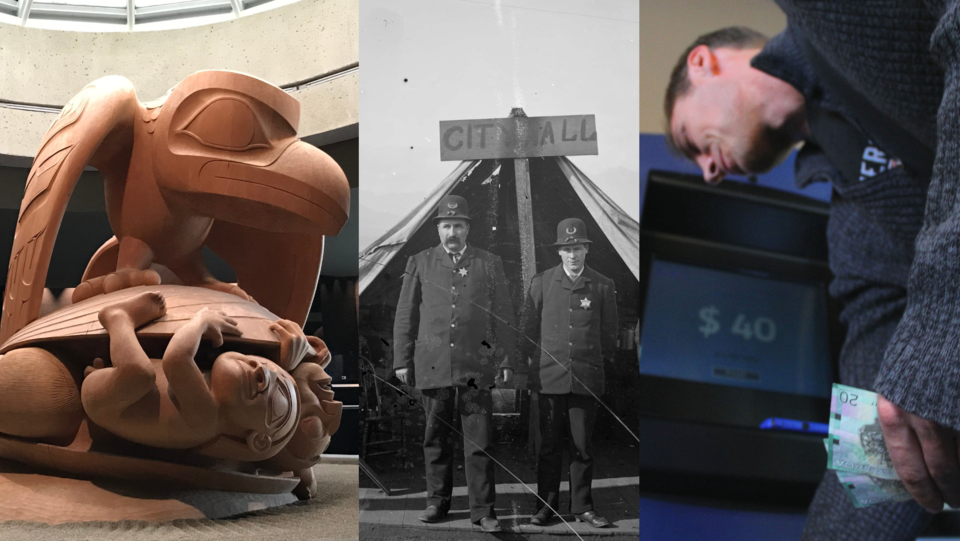Money, as the saying goes, makes the world go around.
Given that it's such a central piece of today's society, it's no surprise that Vancouver has a few unusual interactions with money, starting from the city's foundation.
1. Vancouver's first police badges
When Vancouver's first police force was founded, it wasn't all that easy to just make badges.
So the first ones used by Vancouver officers were made out of American silver dollars, with "Vancouver City Police" stamped on.
2. A bag full of cash and gold
It's unusual to find significant amounts of money around town, but not unheard of. However, even the luckiest people probably don't find $100.
In 1912 some boys playing in Tipperary Park in New Westminster lost their ball in some bushes.
When they dug around to find it, they found something unexpected. About $4,190 in cash and gold in a bag.
Nowadays, 113 years later, $4,190 is still a lot to find anywhere. It's difficult to say what the boys found would be worth today, due to inflation. Also, archival newspapers don't say how much gold was included (which has increased in value at a faster rate than inflation).
However, the contents of the bag would roughly be worth at least $112,000.
Unfortunately for the boys, the discovery was determined to be loot stolen during a hold-up five months earlier and appears to have been returned to the Bank of Montreal. No reward is mentioned.
3. The Vancouver Stock Exchange, aka "the scam capital of the world"
Vancouver had its own stock exchange, known as the VSE, for decades.
It didn't have a sterling reputation.
While many things were written about it, a Forbes magazine article from 1989 summed it up succinctly: "Scam capital of the world."
It wasn't a new thing, either. In 1973 the RCMP estimated up to 30 per cent of the stocks being traded were manipulated.
In 1999 it was merged with the Alberta Stock Exchange, and that was eventually taken over by the Toronto Stock Exchange.
4. The first Bitcoin ATM
Bitcoin is digital-only, but there is a way to turn cold hard cash into cryptocurrency: ATMs.
And the first Bitcoin ATM opened up on Oct. 29, 2013, in a Waves coffee shop in downtown Vancouver at Howe and Smithe streets, just across the road from the courthouse.
North Vancouver was set to become the first city with heating by cryptocurrency, but that appears to have fallen through.
5. Vancouver's representation on Canadian money
Canada has put a lot of things on money, from glow-in-the-dark dinosaurs to UFOs (that also glowed in the dark) to baby footprints.
Sometimes those things are Vancouver-related, like when Vancouver-born Elsie MacGill (who also had a boring machine named after her).
This year, the mint announced a silver coin commemorating Hogan's Alley, Vancouver's first Black neighbourhood.
"Sadly, the community was lost in the 1960s when, despite protests and resistance, the city began levelling it in the name of urban renewal—a devastating blow to its residents. The displacement and erasure of the Black community in Hogan’s Alley have had long-lasting effects," reads the Canadian Mint's webpage for the new coin.
Vancouver is also (sort of) represented on the Canadian Journey Series of bills, released in the early 2000s. The back of the $20 bill is covered in the work of Haida artist Bill Reid, who was based for much of his life in Vancouver.
The two sculptures depicted are both in Metro Vancouver, with The Raven and the First Men on display at UBC's Museum of Anthropology and the Spirit of Haida Gwaii at Vancouver International Airport (it's one of two versions; the other is at Canada's embassy in Washington, D.C.).
Bonus
The Tlingit people are a group of First Nations located on what is now B.C.'s northwest coast and the Alaskan panhandle.
Through dealings with Russian traders, some Tlingit acquired Chinese coins, but not to use as currency. Some of the coins were used to make armour, using the holes in the centre of the coins to sew them onto cloth.
With files from Bob Mackin



